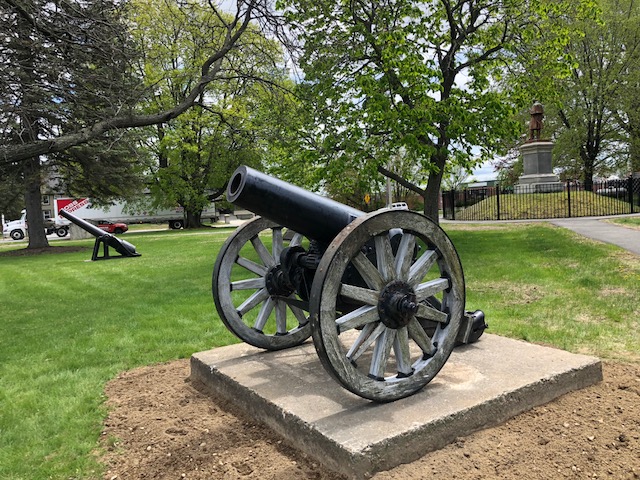WATERVILLE — A German howitzer captured in World War I and placed in Castonguay Square downtown on Armistice Day 94 years ago was moved Wednesday to Veterans Memorial Park at the corner of Park and Elm streets.
The howitzer, commonly referred to as the “cannon,” was moved to prepare for a redesign of Castonguay Square that will take place in conjunction with the future transformation of The Center at 93 Main St. downtown into a center for art and film.
“We knew it had to be moved as part of the project for the redesign of the square,” City Manager Michael Roy said Wednesday. “We have a memorial park with cannons already, and we thought that was a logical place for it to go.”
Mike Folsom, facility maintenance technician for the city’s Public Works Department, and three other employees picked up the nearly 5,000-pound, black howitzer with a bucket loader just after 7:30 a.m. Wednesday and placed it on a trailer. The concrete platform on which it stood was placed on another trailer, and both were hauled by trucks the short distance to the park, according to Folsom.
The cannon, made of nickel steel and with wooden wheel spokes, now sits facing north on a grassy lawn in the veterans park, where it is in good company with three other black cannons. They sit near a Civil War war memorial, dated 1861-1865 and dedicated to the memory of Waterville residents who “gave their lives for the preservation of the Republic.” The memorial was erected by Waterville residents in 1876.
Also in the park is a stone bearing the name “Veterans Memorial Park” in honor of veterans of all wars. It was erected by Bourque-Lanigan American Legion Post 5, of Waterville, and dedicated May 23, 1999 — exactly 20 years ago Thursday.
Ironically, it was the George N. Bourque American Legion post of Waterville that requisitioned the German cannon when it was announced after World War I that the government would be distributing all captured German mounted guns and artillery. According to a Morning Sentinel newspaper story dated Nov. 9, 1925, the Legion paid to have the cannon delivered to Waterville and it was presented to the city during a major celebration on Nov. 11, 1925.

A Waterville public works crew removes the 1890s-vintage German howitzer from Castonguay Square on Wednesday ahead of the redesign of Castonguay Square that will take place in conjunction with the transformation of The Center at 93 Main St. downtown into a center for art and film. The cannon was installed in Veterans Memorial Park. Morning Sentinel photo by Bridget Campbell
According to Earl H. Smith, historian and author of six books, including “Water Village,” a history of Waterville published last year, the Bourque Legion post in 1925 was at the corner of Silver and Spring streets. It was named for Lt. George N. Bourque on June 17, 1919 — 100 years ago — and was the fifth post in the country to be created. Bourque, of Sherman Street Hill, was a Colby College student killed in action in France, the first city resident to die in battle in World War I, according to Smith.
Later, in 1949, a new American Legion post was built on College Avenue and it was named Bourque-Lanigan American Legion Post 5, for Bourque and Seaman Arthur W. Lanigan, the first Waterville casualty of World War II. Lanigan died in 1942 when the USS Houston was sunk, Smith said.
This is the 100th anniversary of Armistice Day, created in 1919 after World War I ended. Smith said the square in Waterville then was known as “The Common,” which that year in May, on the first Memorial Day, was renamed for Master Sgt. Arthur Castonguay, the last Waterville soldier to die in the war. He was wounded in action in the Château Thierry battle in Civray, France, and he died two days later, on June 18, 1918.
Waterville’s website, waterville-me.gov, contains a story about how the howitzer came to be in Castonguay Square.
The city in 2014 learned from James Schoenung, a curator at a private artillery museum in Pennsylvania who had seen the cannon in Waterville, that it was designed in the early 1890s, according to the website. It remained in service by reserve units throughout World War I and is known as the 15cm sFH93 (Schwere Feldhaubitze, or heavy field howitzer), Model 1893. It would have been pulled by a team of six draft horses, and it fired 90-pound explosive projectiles over a distance of 3.5 miles, according to the website. About 600 of the cannons were made.
Roy said Wednesday that credit goes to Waterville Parks and Recreation Director Matt Skehan, who chose the new location for the cannon in Veterans Memorial Park.
Meanwhile, Roy said the city has a conceptual plan for the redesign of Castonguay Square. Colby and Waterville Creates! are raising money for the construction project for the art and film center, but when that project will start is not known yet.
The city has $1 million from a $7.37 million federal BUILD grant to fund the Castonguay Square project, according to Roy.
Send questions/comments to the editors.




Comments are no longer available on this story